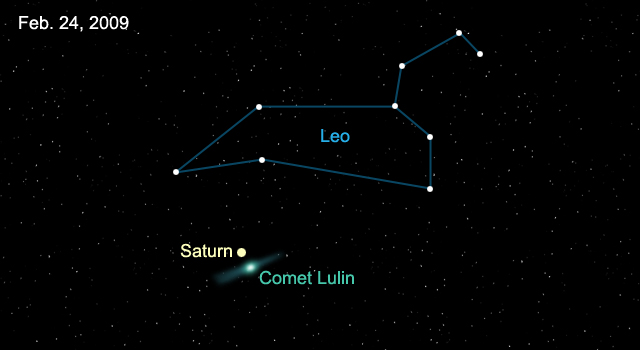We hear a lot about 'going green' these days and it seems even the Universe can't endure one more moment of Al Gore putting his hands together, as if in prayer, and guilting us into investing in carbon trading companies, one of which he happens to own stock in.
As a peace offering, the cosmos is offering comet Lulin, which is making an appearance in the nighttime sky this month - and it's green. Literally. Don Yeomans of JPL, manager for NASA's Near-Earth Object Program Office, answers a few questions about this odd comet.

Sky chart showing comet Lulin on Feb. 24, 2009. Image credit: NASA/JPL
Q: Why is comet Lulin green?
A: The green color arises when ionized cyanogen and carbon gases in the comet's atmosphere emit radiation in green wavelengths. These gases vaporize when the ices in the comet's nucleus get close enough to the sun.
Q: What other unusual characteristics does the comet have?
A: Comet Lulin is moving nearly in the same orbital plane around the sun as do the planets, but in the opposite (retrograde) direction. It is probably the first time this comet has entered the inner solar system, so some of its original volatile ices in its nucleus may still be present, and should be identifiable during observations.
Q: Will we be able to see comet Lulin and its greenish color? If so, where, when and how?
A: The comet should be observable in dark skies with binoculars. The best time to observe might be near its closest approach to Earth (about 38 million miles) on Tues., Feb. 24, when the comet appears just below the planet Saturn in the constellation of Leo (high in the southeast in late evening for observers in mid-northern latitudes, for example, in the United States and Europe.
Q: Will NASA astronomers be tracking the comet?
A: A small army of amateur and professional astronomers will certainly take advantage of this young comet using various telescopes and in many different wavelengths. It is not that often that a relatively bright, young comet is seen in the inner solar system, and astronomers will take advantage of this opportunity to identify some of the gases that make up its greenish atmosphere - and infer what exotic ices make up its unseen nucleus.





Comments